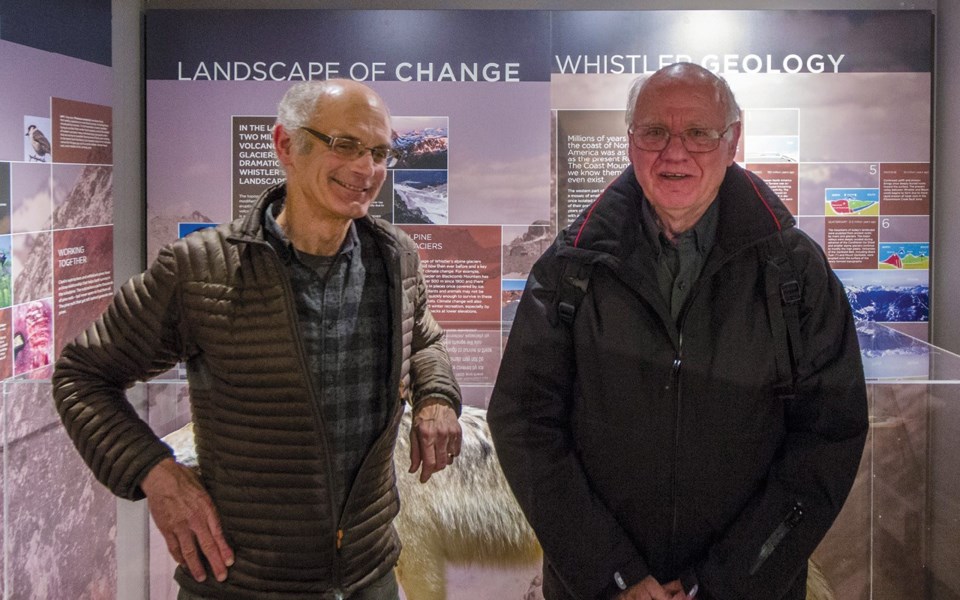When Arnold Shives and Glenn Woodsworth met as teenagers, they couldn't have imagined where their shared love of the mountains would take them.
For the next decade, they helped pioneer mountaineering in the Coast Mountains, forming a closeness that was on display at their Nov. 15 talk, "Crevasses and Crags: Tales from the Coast Mountains" at the Whistler Museum.
The two, who wore button-up shirts and glasses, resembled long-lost brothers.
In front of a group of 40, Shives and Woodsworth shared photos of a series of impressive trips they took in the 1960s and early 1970s.
The men's earliest adventures, they recalled, were in and around the Sky Pilot area, just east of Britannia Beach.
Accessible from their home in Vancouver, it provided an early playground, and they learned through doing experiencing their fair share of sketchy situations.
As part of the first wave of B.C. mountaineers, they were exploring largely uncharted (or very recently charted) territory.
Shives recalled the wonder of it all, as a photo of them climbing a steep, shale face was projected on the wall behind him.
"I think we were blissfully ignorant of the risk — anyway, we survived," he said, garnering a laugh from the audience.
During those days, the men looked up to Dick Culbert, a legendary mountaineer who was a few years older.
It was Culbert who figured out a way for the trio to go deep into the mountains.
At the time, the British government was giving out grants for prospectors, and Shives and Woodsworth had skills that most prospectors didn't — an ability to navigate the difficult terrain.
They didn't, however, have the geological knowledge. But they were quick studies and were able to pass a test that allowed them to qualify.
They got "a princely sum" of $300 to $400 for the summer.
It was "a great scheme to get into the mountains on someone else's dime," recalled Shives.
Through the grants, Shives and Woodsworth spent summers in the Howe Sound and Waddington Mountain ranges.
Their photos of the era, dramatic early-colour shots, are spectacular.
They were gruelling, extreme trips, crossing fast-moving rivers and scaling glaciers with dangerous crevasses.
And their gear, to say the least, was basic: small A-frame tents, massive bags — stuff they bought from an army-surplus store.
"We weren't going Gucci," said Shives.
Through their time in the backcountry, Shives and Woodsworth were able to amass first descents and first routes. And Woodsworth, who took a liking to rock climbing, helped pioneer Squamish's now world-renowned rock climbing scene. In those days, the anchors were few and far between, he recalled.
Both men also developed intellectual pursuits related to the mountains.
For Shives, it was art. During his trips he sketched and painted, inspired by the beauty of the mountains.
Over the course of the presentation, he showed his early work, monochromatic paintings of striking mountains, including Mount Garibaldi.
Some of Shives work is currently being featured in Stone and Sky: Canada's Mountain Landscape, an exhibit focusing on Canada's alpine at the Audain Art Museum.
Woodsworth went on to study geology, and has since worked with the Geological Survey of Canada.
Following the talk, Shives and Woodsworth were asked about their spiritual connection to the mountains — a theme that had come up.
Woodsworth, a self-described atheist, said mountaineering involves a "leap of faith."
You have to have total confidence in your climbing partner, he explained. "There's a great deal to be said for that."
"They're very spiritual places — however you want to define spirituality."
For Shives, a practicing Catholic, mountains have always inspired wonder.
"Nature itself is a holy scripture for me," he explained.
"The higher you go the more sublime it is.
"I think that's what drove Glenn and me, when we were kids of 16. We wanted to get higher." I




